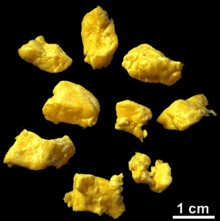Curd
Curd is a dairy product obtained by coagulating milk in a process called curdling. The coagulation can be caused by adding rennet or any edible acidic substance such as lemon juice or vinegar, and then allowing it to coagulate. The increased acidity causes the milk proteins (casein) to tangle into solid masses, or curds. Milk that has been left to sour (raw milk alone or pasteurized milk with added lactic acid bacteria) will also naturally produce curds, and sour milk cheeses are produced this way. Producing cheese curds is one of the first steps in cheesemaking; the curds are pressed and drained to varying amounts for different styles of cheese and different secondary agents (molds for blue cheeses, etc.) are introduced before the desired aging finishes the cheese. The remaining liquid, which contains only whey proteins, is the whey. In cow's milk, 90 percent of the proteins are caseins.
In Indian English, used only in the Indian subcontinent, curd or curds instead refers to the traditional homemade yogurt (also known as dahi[1]), while paneer and chhena are used to denote curdled milk. Though people often consider curd and yogurt to be the same, there's a thin line of difference between the two.[2] The preparation of curd requires a lactobacillus bacteria, while yogurt is made using two specific strains of bacteria called Lactobacillus delbrueckii subsp. bulgaricus and Streptococcus thermophilus bacteria. Other strains of lactic acid bacteria may also be added.[3] [4]
Types of curd
There are two methods to make curd, with rennet and with acid. Using acid, like lemon juice, lactic acid to make curd releases the lactose into the water. Thus the solid curd formed from this method is good for people with lactose intolerance. This type of curd is known as Chhena in India.
Using rennet to make curd attaches the lactose to the solid coagulated proteins. Thus it is not recommended for people with lactose intolerance. This type of curd is the commercial cheese available in supermarkets, such as Cheddar, Mozzarella, Swiss, Parmesan. Vegetarian rennet, usually from Withania coagulans, is used to make paneer in India.
Uses
Curd products vary by region and include cottage cheese, curd cheese (both curdled by bacteria and sometimes also rennet), farmer cheese, pot cheese, queso blanco, and paneer. The word can also refer to a non-dairy substance of similar appearance or consistency, though in these cases a modifier or the word curdled is generally used.
In England, curds produced using rennet are referred to as junket; true curds and whey are produced from the natural separation of milk due to its environment (temperature, acidity).
Cheese curds, drained of the whey and served without further processing or aging, are popular in some French-speaking regions of Canada, such as Quebec, parts of Ontario, and Atlantic Canada. Throughout Canada cheese curds are served with french fries and gravy in a popular snack called poutine. Curds are also typical of some Germanic-descent regions such as historic Waterloo County in Ontario.[5]
In some parts of the Midwestern U.S., especially in Wisconsin, curds are eaten fresh without further additions, or they are breaded and fried.
In Turkey, curds are called keş and are served on fried bread and are also eaten with macaroni in the provinces of Bolu and Zonguldak.
In Mexico, chongos zamoranos is a dessert prepared with milk curdled with sugar and cinnamon.
Albanian gjiza is made by boiling whey for about 15 minutes and adding vinegar or lemon. The derivative is drained and salted to taste. Gjiza can be served immediately or refrigerated for a couple of days. (This sounds more like riccotta: hot whey separated -- from the curds -- and colagulated with vinegar)

See also
- Aarts, Mongolian fermented curd, eaten as a dried snack or reconstituted as a hot beverage
- Chongos zamoranos, a dessert prepared with milk curdled with sugar and cinnamon
- Cuajada ( or Coalhada), usually sweetened and eaten for breakfast or dessert, popular in Spain and Central America
- Curd snack, a snack popular in the Baltic States
- Çökelek, a form of fermented buttermilk or yogurt curd from Turkey
- Farmer cheese
- Hoop cheese
- Key lime pie, prepared by curdling condensed milk
- kesú paraguay, a paraguayan formed cottage cheese
- Kurt or Qurut, central Asian cheese curd
- Ostkaka, Swedish style cheese cake, some call it a Swedish National dish
- Paskha, a Russian Easter dessert made of quark
- Ricotta, an Italian whey cheese
- Skyr, Icelandic curd
- Tofu, the coagulated product from soy milk, from eastern and south-eastern Asian countries
- Túró Rudi, a Hungarian chocolate bar with curd
- Urdă, a Balkans fresh white cheese made from whey.
- List of dairy products
References
- Curd -Indian English Dictionary)
- Curd vs Yogurt -The difference
- How is yogurt different from curd
- What's the difference between yogurt and curd
- "Curds 'n' Whey 'n' Poutine". Waterloo Region Eats. 2015-12-21. Archived from the original on 2018-04-03. Retrieved 2018-04-16.
